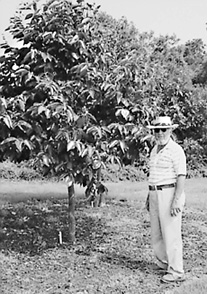 Eden
Eden Eden
EdenIn Our Own Back Yards
New Life Flowers In Local Gardens
by Kim Cammarata
photo by Kim Cammarata Dr. Frank Gouin with one of the world's eight Patapsco persimmon trees, at right.
Listen to Charles and Wanda Hanners talk of azaleas and you remember the way new parents caress the downy head of their child. Listen to Dr. Frank Gouin talk about persimmon trees, and you hear the kind of pride you'd expect from a father whose son had hit a Little League homerun.
They are creators from whose hands spring varieties of plants that have never before existed on earth.
"When you grow an azalea and it's different from the ones you have, there is a tendency to look at it as your offspring. There's a paternal/maternal look at this thing," said Charles Hanners as he rested from his labors at Azalea Trace, the seven-acre, sun-dappled Eden he and his wife Wanda have created on rolling hills in Calvert County.
She agrees: "I look at it like another child."
Azalea Trace looks and feels like natural woodland. Only the neat paths bordered with logs and the silver name tags identifying each of the more than 1,700 varieties of azaleas disturb the pristine appearance of the land.
That's 1,700 different registered varieties. Plus several thousand more of the Hanners' own creation. More azaleas grow on the seven acres of Azalea Trace than in the National Arboretum.
"Our only claim to fame here is that we have many, many different varieties of azaleas. That's what we specialize in," says Charles Hanners, modestly. "We honestly don't know anyplace else you can go in this area where you will find so many varieties."
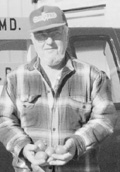 Creators
seem to abound in Chesapeake Country.
Creators
seem to abound in Chesapeake Country.
Up the road in Deale, Dr. Frank Gouin, at right, (photo by Sandra Martin) feels much the same way about nurturing and multiplying a rare new breed of Oriental persimmon tree.
"When I was an undergraduate, I lived with a country doctor," Gouin recalls. "He had delivered over 2,000 babies, and he always told me that every one of them was as much of a mystery as the first one. The Lord created these trees. We modified them to meet our needs. They're a creation. They're something that needs you and you need them."
A retired University of Maryland professor of horticulture and a world authority on composting, Gouin lives and works plant wonders on a paradise of his own, Upakrik Farm. With neat rows of Christmas trees, precise topiary sculptures, orderly gardens full of flourishing vegetables and herbs and flower beds brimming with colorful blooms, Upakrik Farm is a glorious testament to his life's work.
Amongst all this beauty, Gouin bestows a place of honor to this one rare fruit tree, the Patapsco persimmon. And rightfully so: in the whole world, there are only eight Patapsco persimmons. Scattered from Beltsville to Upper Marlboro to the Wye River on the Eastern Shore, each one is a rare gem.
What's So Special About a Persimmon?
What's so special about the Patapsco persimmon? For that matter, what is a persimmon?
A fruit tree with many virtues, Gouin will tell you. Most importantly, it will survive the winter in Southern Maryland, a feat not achieved by other types of Oriental persimmon trees. The Oriental persimmon, first introduced to the United States in 1856, prefers the warmer climate of its native homes in Japan, China and Korea.
Gouin's lollipop-shaped tree is also beautiful, reaching 10 feet tall with deep green leaves. Even better, the tree is resistant to disease and insects and never needs spraying - as other backyard fruit trees must - with chemicals harmful to the Bay.
The orange persimmon fruit, which ripens in October, is gorgeous as well as delicious. These Patapsco persimmons are not our poor native persimmons - small, sour fruit that make the mouth chalk and pucker - but large, sweet, seedless fruit with a taste even better than papaya. The texture ranges from that of a peach when the fruit is firm to tapioca when the fruit is very soft.
"It's a delicious flavor," Gouin exclaims. He hopes his enthusiasm for the tasty persimmon is contagious.
"I'm trying to build a market, to get people to like persimmons. I don't know too many Americans who like them; persimmons have gotten a bad reputation because people think of the native variety which is very astringent," he says.
Other parts of the world adore them already.
In Japan, the Oriental persimmon is a delicacy. Most homes own a persimmon tree. "A Japanese friend of mine comes here every year to get some persimmons," Gouin says.
Gouin has been testing the demand for persimmons at different farmers' markets. Unsurprisingly, he says the fruit sells quickly in communities with a large Asian-American population.
"Asians go bananas when they see persimmons. But I think Americans ought to learn like them too," he says.
The Patapsco persimmon tree is still so new that it's not yet available in commercial nurseries.
Azaleas on Parade
The Hanners, on the other hand, don't need to convince anyone of the virtues of azaleas. With their profusion of springtime blooms in colors so rich they seem to glow, azaleas have long been a landscaping favorite in this region. But few realize how many different varieties of azaleas exist.
photo by Kim Cammarata
At their home and business, Azalea Trace, Wanda and Charles Hanners , at
left, nurtured 1000s of azaleas of which many are their own creations.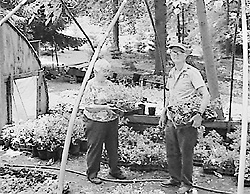
In addition to the color of the blooms, a surprising number of characteristics combine to make an azalea unique. The Hanners know them well.
There are different flower types. For example, there's the single with one row of petals, the semi-double with one row of petals with a little tuft in the center, real double with two rows of petals with a large tuft in the center, Charles Hanners says.
Leaves and plants are as various as flowers. "There are many different leaf styles: some are barely one-quarter inch long, while others are four to five inches long, with everything in between. Some azaleas grow only a few inches high; some grow up to be towering things 10 to 15 feet tall," he continues.
Some azaleas, those native to this country, are deciduous, losing all their leaves in the fall. Others are evergreen, keeping their leaves throughout the winter.
Evergreen azaleas are immigrant to the United States. "All evergreen azaleas are imported," Hanners notes. Most evergreen azaleas in this area of the country originated in China and Japan.
An azalea cross-breeding project during the 1930s, sponsored by the United States Department of Agriculture at their facility in Glenn Dale, Maryland, created over 400 new varieties of evergreen azaleas. Unlike their Chinese and Japanese parents, these new breeds of evergreen azaleas - known as the Glenn Dale Azaleas - could withstand the colder climate of our region.
This ability to withstand cold is perhaps the most critical azalea characteristic - literally a life or death matter. Not all azaleas can endure Maryland winters; the Hanners have several "florist azaleas" that must spend winters at Azalea Trace indoors or freeze to death. However, these same plants can survive the winter in warmer climates to our south.
Plenty of azalea varieties do survive our winters, thanks to the Glenn Dale project and people like the Hanners who improve upon nature by cross-breeding plants to bring out desirable traits.
As for their original creations, Hanners explains that all they can claim is that the azaleas and seedlings they have so far have been winter hardy in Calvert County.
Nature may still take her toll. "If temperatures dropped down to zero degrees and stayed that way for four days, how many azaleas would we have? I don't know," Hanners says.
photo by Kim Cammarata In spring, you can visit the Hanners' farm to choose from the 700 azalea varieties they sell.
All these characteristics combine in almost infinite ways.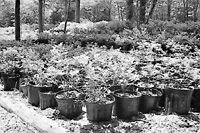
"There are somewhere in the neighborhood of 6,000 different azaleas that are registered now," Hanners reports. This number doesn't account for the thousands of unregistered varieties created not only by him and his wife but also by other azalea enthusiasts throughout the world.
But don't expect to run down to your local garden store and find all 6,000 varieties. Six years ago, Hanners surveyed all the major azalea growers east of the Mississippi that were listed in the trade magazine American Nursery. He determined that about 200 varieties are available in the marketplace.
"There was not a single place where I could get all 200 of them. Some places advertised over 100, but when I talked to them they wouldn't have most of them available for two or three years," Hanners says.
At Azalea Trace, the Hanners reproduce 700 varieties of azaleas to sell. Some are common, others so rare there's no place else in the world you can get them.
But most of Hanners' customers are not looking for rare and unusual azaleas.
"Most people who come here to buy plants are not interested in all these varieties. People often want a specific color. One woman came here this year with a brick from her house. She wanted the azalea blooms to match," he remembers.
Whether you're a serious azalea collector seeking a new prize or an average homeowner looking for a pretty shrub, you'll find your fancy at Azalea Trace.
True 'Amateurs'
photo by Kim Cammarata Some of Charles Hanners' azaleas are so rare that there is no where else in the world that you can find them.
"I'm not a plant scientist; I'm a plant enthusiast." That's
how Hanners sums up his approach to breeding azaleas.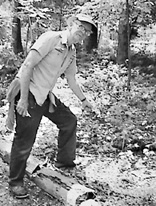
Growing and breeding azaleas started as a hobby for the Hanners and blossomed from there. They bought the entire azalea stock from a failed nursery more than 20 years ago to use as landscaping plants for their new home near Bowie. They had no idea what they were getting into.
"I wasn't sure what I was buying at the time because the plants were overgrown with weeds, and I couldn't really see what was there," Charles Hanners remembers. "Worst of all, most of the labels were so faded I couldn't read them."
When the azaleas bloomed again the following spring, Hanners brought some limbs from the plants to a flower show sponsored by the Azalea Society of America, hoping to identify the plants. Instead he was overwhelmed - but fascinated - by the diversity of azaleas he found at the show.
That fascination inspired him to start some seeds he'd collected from his plants.
"I was surprised they grew," he says. Later he would read how to do it properly, to get the best growth.
Success with those seedlings led Hanners and his wife to experiment with cross-breeding different azaleas, just to see what they'd get.
They got hooked on azaleas.
Much trial and error and hard work over the years resulted in today's thriving business that sells 7,000 azaleas every year.
Professional Legacy
Gouin "inherited" the Patapsco persimmon project 20 years ago from his friend and former University of Maryland colleague, Dr. James Shanks. Shanks, experimenting with cross-breeding Oriental persimmon trees, had created a new breed that not only survived Southern Maryland winters but also had a sweet, seedless fruit - a delicious surprise.
Shanks "always had an interest in persimmons, especially the large-fruited Oriental varieties," says Gouin. "When he left, he said 'I wish somebody would take over this project,' so I haphazardly said I'd watch over it."
Gouin was soon passionate about persimmons, too. Now his self-appointed job is developing the best technique to reproduce this rare and wonderful tree for all to enjoy.
Breeding brand new plants and then learning how to multiply them is a partnership between humans and nature, according to Gouin.
"We have learned to work with nature, not against nature. When you start to work with nature, you realize she knows a whole lot more than you do. You can do all the reading you want, but Mother Nature is the test of these things," he avows.
Plant Breeders Give Mother Nature a Hand
photos by Kim Cammarata Shrubs
like azaleas can be reproduced, or cloned, by cuttings. Trees like the persimmon
must be grafted. 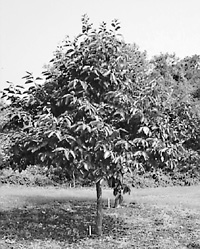
Nature creates brand-new plants on her own all the time. In spring, flowering plants produce clouds of yellow dust known as pollen. Traveling from one plant to another by way of wind, birds and bees, the tiny pollen particles enter a long, slender tube in the center of a flower, the pistil. This process fertilizes the plant so it may produce seeds.
Each pollen particle produces one seed or "child." But a single "mother" plant may receive pollen from dozens of "father" plants, resulting in seeds with different gene combinations. For this reason, a plant that grows from a seed may be surprisingly different from its "mother," and different seeds from the same seed pod may produce plants quite distinct from each other.
Creators like the Hanners, Gouin and his friend Shanks work in partnership with nature. Instead of allowing natural fertilization of their azaleas and persimmon trees, these plant growers control pollination. First, they choose parent plants with desirable traits.
Consider the Hanners' azalea with beautiful reddish leaves, which they love. But the plant is too fragile to survive outdoors through the winter in Southern Maryland. They'll cross that plant with another azalea that survives easily through the winter and hope for a hardy offspring with red leaves.
After the parents are chosen, they must cross-pollinate.
"There is no mystery or trick to pollination," explains Hanners, "All one needs to do is take some pollen or even the whole flower [from one plant] over to another plant and dab it onto the pistil of a flower. Then isolate the flower with a plastic bag to prevent contamination by unwanted pollen."
The mature seeds of this union are planted and the seedlings left to grow so the plant breeder can see what's what.
Seeing what springs forth from these seeds is Wanda Hanners' favorite part of the cross-breeding process. "I like the seedlings because every one is so different. That's exciting," she explains.
But when a breeder tries for a specific result, like a hardy red-leafed azalea or an Oriental persimmon that will survive Southern Maryland winters, patience and persistence are paramount.
Gouin's colleague Shanks first crossed two varieties of Oriental persimmon trees, resulting in seven seeds. He repeated this process until he had 800 seedlings. From those 800, only six had the trait he was looking for: ability to withstand cold.
He knew the 793 had failed his test when they withered and died from the cold.
When a desirable new plant is finally achieved, the only way to get identical children is by cloning the parent. Its seeds will not reproduce it exactly.
But the Hanners clone an azalea in a different way than Gouin clones a persimmon.
Multiplying an azalea requires faith in nature's ability and some patience: the Hanners must wait five years from planting to selling. The faith comes in when a small piece of branch, about four inches long, is clipped and dipped into a substance that promotes root growth. One of the Hanners then sticks the cutting into a soil mix in a wide, flat container. These baby azaleas grow up in a frame that controls sun and moisture until roots form.
Up to 75 percent of the new plants make it through the first critical year. Each of the next four years, they'll be transplanted into larger pots. After the fifth year, they're ready for adoption.
Multiplying persimmon trees is different - and more difficult - than multiplying azaleas. Unlike the cooperative azalea, a persimmon tree won't grow from a cutting.
"The only way to propagate [a persimmon tree] is by grafting," explains Gouin.
When grafting the Patapsco persimmon, Gouin transplants a small branch from his one prized tree at Upakrik Farm onto the roots of a pencil-sized seedling of the strong native persimmon tree. The growing parts of the branch and the roots (visible as a thin, green ring right under the bark) must line up exactly. Amazingly, when the graft is right, the two trees will grow together as one: the Patapsco persimmon upon strong native persimmon tree roots.
A delicate skill in general, grafting persimmon trees is particularly difficult. Gouin says, "I've done 300 grafts and only have six trees to show for it."
Does he get discouraged?
The scientist in Gouin speaks, "No. I did research for 30-some years. [When your grafts fail] you sit back and wonder what's the next technique."
A Persimmon in Every Yard
Gouin's ultimate goal is for you to be able to buy your own Patapsco persimmon. Before that can happen, he must perfect the persimmon grafting technique so that 80 percent of the grafted seedlings survive. Large nurseries will agree to sell a brand new plant like the Patapsco persimmon only if it can be reliably reproduced.
With a success rate of about two percent, Gouin has plenty of work ahead of him, but he keeps plowing ahead undeterred because he believes in the value of the Patapsco persimmon.
Says Gouin: "Persimmons are a good backyard fruit tree, especially around the Bay because they don't have to be sprayed. It produces excellent edible fruit and has tremendous ornamental value."
Hanners also dreams that one of his creations will someday reach the mass market. A commercial grower is considering a dozen of the Hanners' original plants for large-scale production. Whichever azalea triumphs, Hanners has already stipulated that it be named for his gardening grandfather, Charles Read.
In all this, the Hanners aren't looking for glory; they simply want others to delight in the azaleas that they have created.
Their delight is plain to see.
"My only regret is that I didn't buy 20 acres here when I bought this land. We have room for another 1,000 azaleas here, but that's about it," Hanners laments.
How long would it take he and his wife to collect another 1,000?
"About 15 minutes," he replies, passion glowing in his eyes and a smile on his lips.
Reach the Hanners at Azalea Trace at Huntingtown in Calvert County 301/855-2305 or 410/257-0837.
Wanna Try a Persimmon? 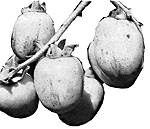
If you're ready to try a Patapsco persimmon, you'll find them when they ripen in October at Thompson's Produce Market on Muddy Creek Road in West River.
In addition, both Oriental and California - larger versions of the native American fruit - persimmons have a short run in grocery stores around the same time, where they cost about $1 apiece.
 Buy persimmons that
give a little when pressed and have translucent skin to eat right away.
Buy persimmons that
give a little when pressed and have translucent skin to eat right away.
If the fruit feels firm, the skin will be unpleasantly astringent, warns Gouin. He knows how to make a firm fruit ready for immediate eating: put the fruit in a paper bag with some apples until slightly soft or spray the fruit with a little gin or vodka to sweeten the skin.
You can enjoy a persimmon many different ways: eat it like an apple, skin and all; cut in half and eat with a spoon when the fruit is very soft; freeze one and eat it like a Popsicle; slice and dehydrate the fruit like the Japanese do; mash into pulp and dehydrate to make fruit leather.
-KC
| Back to Archives |
VolumeVI Number 32
August 13-19, 1998
New Bay Times
| Homepage |